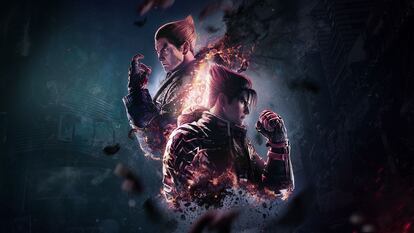‘Tekken,’ video games and competitiveness
The creator of the fighting game franchise reflects on the possibilities of interactive entertainment: ‘There are games that, for their aesthetics and narrative, would be in the category of art, but that is not what we want’

Video games are culture. In fact, they are cultural artifacts that provide a context for the creation of artistic works that sometimes break formal boundaries; occasionally, they even enter into dialogue with the world in which they live in ways that other fine arts currently do not. That is this column’s main argument, and the primary way video games are treated in this medium. But that is only part of it. In truth, video games are much more than that. They are cutting-edge technology. They are a rising economic phenomenon at a moment when everything else seems to be shrinking. And in the digital arena, they are a new field for experiencing one of the most human characteristics of all: competitiveness.
Not long ago we talked about Japan Weekend, the extraordinary influx of people and how the impact of manga and anime on new generations (also K-Pop) is demonstrating that soft power is no longer American but Asian. That event took place in the Ifema convention center in Madrid, Spain. This weekend, there was another event that occurred at the same place; the latter addressed the other side of the coin: the sportier side of video games: Gamergy.
Other than the consumption of energy drinks and the omnipresence of all kinds of screens at both gatherings, the two events had nothing to do with each other. In Gamergy, the attendees’ average age was 10 to 15 years older than those at Japan Weekend (attesting to digital culture’s generational stratification). And at the latter event there was less cosplay but much more competitiveness. The Ifema pavilion rang out with cheers every time a Valorant team eliminated another one and applause when a Tekken player got a perfect score. The star of the event was Katsuhiro Harada, one of the creators of the fighting game, which will turn 30 in 2024. Harada attended the gathering to present the award to the European Tekken Cup winner. EL PAÍS spoke with Harada (who was wearing his ever-present sunglasses) to reflect on many of the issues mentioned above.

“We will not see a radical change in the video game industry in five years,” says the Japanese-born Harada, 53. “Cloud gaming has slowed down and the predictions of 10 years ago, which said we would not have consoles, just a controller and a TV connected to the Internet, have not come true. Computer gaming has grown a lot, mind you. Not only in countries with more complicated access to consoles; it has grown a lot, even in Japan,” he explains. The computer is a medium that has led to the emergence of eSports as a phenomenon, as those who flocked to the Ifema event center over the weekend demonstrate, but Harada does not believe that video games should “depend only on the eSports model. Young people feel an affinity for them, and they are on everyone’s mind, but they should not be the only thing [we] focus on,” he says. Harada adds that, in eSports, the economic impact does not have a direct effect on the companies and the creators, but rather remains with the mediators of the big events.
“Transmedia intellectual property rights are a company’s dream,” the producer says of this trend in popular culture. “But they’re expensive, because if you want a good story, you have to invest in it. The same [is true of] striking images and designs, you have to invest.” He adds that “if you want to make toys out of the characters, they have to be appealing characters in a particular way,” perhaps advocating a future of cloned products to satisfy the market demand. “It’s the companies’ dream, yes, but it’s the hardest thing to achieve.”
Finally, the Japanese master talks about another recurring but necessary topic: having moved beyond the debate over whether or not games are art, there’s the question of whether video game creators are artists or not? “The difference between the West and Japan is curious,” he says “When I travel, when I get awards, I’m considered an artist, what we call a man of culture in Japan. It’s an interesting debate, but at Tekken we don’t want to elevate our game to artistic status. We want to make a product that is entertaining and as interactive as possible,” he reflects. Indeed, there’s a gap between the West (which tends to assert the artistry of videogame developers more) and the East (which is more inclined to deny such claims).”There are games that, yes, for [their] aesthetics, for [their] narrative, would fall into that category, but that’s not what we want,” he says. We have already talked a lot about those games, about games with transcendent aspirations. But increasingly we also have to talk about the competitive, entertaining part, the strictly recreational mass phenomenon. Even if it is far removed from the cultural path that is full of video games these days.
Sign up for our weekly newsletter to get more English-language news coverage from EL PAÍS USA Edition
Tu suscripción se está usando en otro dispositivo
¿Quieres añadir otro usuario a tu suscripción?
Si continúas leyendo en este dispositivo, no se podrá leer en el otro.
FlechaTu suscripción se está usando en otro dispositivo y solo puedes acceder a EL PAÍS desde un dispositivo a la vez.
Si quieres compartir tu cuenta, cambia tu suscripción a la modalidad Premium, así podrás añadir otro usuario. Cada uno accederá con su propia cuenta de email, lo que os permitirá personalizar vuestra experiencia en EL PAÍS.
¿Tienes una suscripción de empresa? Accede aquí para contratar más cuentas.
En el caso de no saber quién está usando tu cuenta, te recomendamos cambiar tu contraseña aquí.
Si decides continuar compartiendo tu cuenta, este mensaje se mostrará en tu dispositivo y en el de la otra persona que está usando tu cuenta de forma indefinida, afectando a tu experiencia de lectura. Puedes consultar aquí los términos y condiciones de la suscripción digital.









































